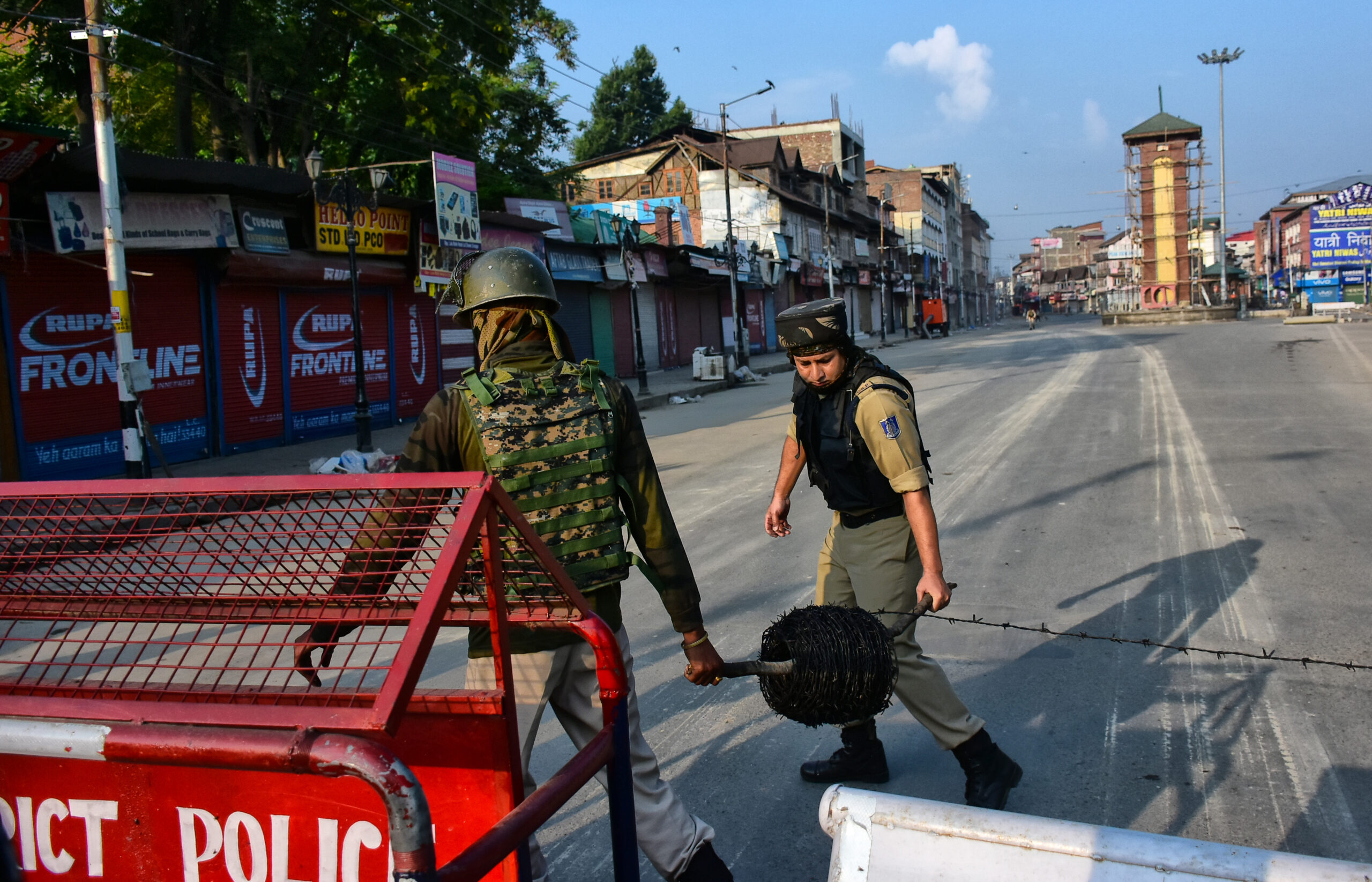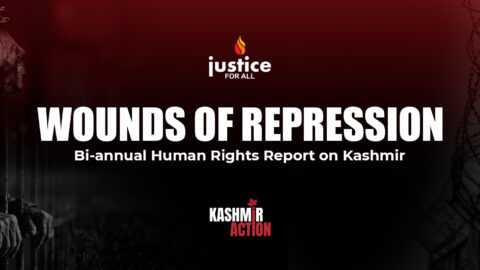
Kashmir Files: Demystifying The Pandit Question and Mass Manipulation
Cinemas across the world, including the US and Canada, are screening the movie ‘The Kashmir Files’, a Hindu right-wing propagandist depiction of the exodus of Kashmiri Hindus in the 1990s. The movie presents Kashmiri Muslims as responsible for the “ethnic cleansing” of Kashmiri Hindus from the valley, appealing to the pre-existing sensibilities of Islamophobia that have become normative and mainstream in India in the recent past. After the screening of the movie in India, many incidents of anti-Muslim sloganeering were reported in cinemas across India. In one such incident of sloganeering, a man raised from his seat and declared, “If every (Hindu) man started marrying (Muslim) girls then their population will be reduced to half after three generations. They will give birth to a smaller number of children. We are watching a film here and Muslims are increasing in population at home!”. Narendra Modi, the Hindu nationalist Prime Minister of India, praised the movie and a state leader from the BJP gave government employees a half-day off to see the movie, while supporters of Modi and the BJP endorsed the movie on social media. The movie has been made tax-free by many states, so as to increase its viewership as much as possible. All of it is being done to popularize anti-Muslim sentiment in India, as is evinced by the reaction the movie produced in various cinemas.[1]
The major problem with the film is that it’s factually incorrect, and it mischaracterizes one of the most vulnerable periods in Kashmir’s history. While the film claims that thousands of Kashmiri Hindus were murdered by Kashmiri Muslims, the fact is that no such ethnic cleansing ever took place. All in all, a total of 219 Kashmiri Pandits were killed for 15 years spanning 1989 to 2004[2], according to an investigation carried out by the Indian government’s Ministry of Home Affairs in 2005. While it’s true that one must not minimize the loss of even a single life, the film conveniently obfuscates the truth that tens of thousands of Muslims were killed or disappeared by Indian armed forces during this same period and all these killings have been documented[3].
The Myth of “Communal” Killings in Kashmir
It is pertinent to keep in mind the political context in which some of the Kashmiri Hindus were killed by the armed rebels. The anti-India rebels would target pro-India Kashmiris, regardless of their religious affiliation, and particularly those Kashmiris who worked for India’s intelligence agencies.
For example, Neel Kanth Ganjoo, a Pandit judge who had sentenced Maqbool Bhat, a very popular pro-freedom Kashmiri civilian leader, to death, was killed by rebels in an act of revenge.[4] The film takes such incidents out of context and weaponizes them to propagate anti-Muslim animosity, by presenting the killings as religiously motivated. Thousands of Kashmiri Muslims who are beneficiaries or supporters of the Indian government and military have been killed by the rebels, which further substantiates the political motives of the violence and undermines the film’s effort to dehumanize the Kashmiri Muslims. It also disrupts the attempt made to present the exodus as genocide due to the Hindu religious identity of the victims. In stark contrast to government figures, the film exaggerates the number of Kashmiri Pandits killed in the Valley with the plan of labeling Kashmir’s political movement for self-determination as an ultra-radical terrorist movement. The first combatant who was attacked by the armed rebels in Kashmir was not a Kashmiri Pandit, but a pro-India Kashmiri Muslim police officer named Ali Muhammad Wattali.
The first non-combatant who was killed by the armed rebels was a Kashmiri Muslim, named Muhammad Yusuf, who was an activist with the National Conference, a pro-India political party that supported Kashmir’s illegal accession with India and jailed all dissidents. Besides Muslims being the first to be killed in the politically motivated rebellion, they were also the first to be abducted. It was the daughter of the then Indian home minister, Mufti Sayeed, who was abducted by an armed resistance group and later released after five Kashmiri pro-freedom activists were released by the government in return.[5] All of it points to a very clear fact: the binary of the Kashmiri Muslim as the perpetrator and the Kashmiri Hindu as the victim, which the film constructs, cannot be sustained. The film also erases the seven decades-long state-led violence against the Kashmiri Muslim population and aims at delegitimizing their movement for self-determination through the phantasm of the Pandit “genocide”. Civil society and human rights organizations put the death toll of Kashmiri Muslims since 1989 at about 100,000 and most of these killings were led by the state.
In The Words Of Kashmiri Hindu Pandits
In the year 2010, Raman Bhalla, the then Revenue Minister, declared in the Kashmir assembly, ‘219 Pandits were killed in Kashmir from 1989 to 2004. From 2004, no killing of any person from the community [Kashmiri Hindus] took place.’[6] The Pandits who did not leave Kashmir were never harmed by the local populace and instead have lived very harmoniously with them.[7] According to Suman Vikash Bhat, a 33-year-old Kashmiri Hindu assistant professor of Microbiology at Islamic University of Science and Technology, during the 1990s, when rebellion against Indian rule was at its peak, the Indian army would often take out their frustrations when their soldiers were killed on the civilian population, regardless of religion. As a community, according to Bhat, Kashmiri Pandits were not spared the indiscriminate crackdowns and violence that Kashmiri Muslims were subjected to.
Nishita Trisal, another Kashmiri Pandit and doctoral candidate in sociocultural anthropology at the University of Michigan, argues, “Instead of treating Kashmir as a political matter, the Bhartiya Janata Party and its allies have turned it primarily into a communal and economic one. They have stoked Kashmiri Pandits’ felt experience of injustice by pitting Pandit and Muslim suffering against each other.” A very prominent Kashmiri journalist, Anuradha Bhasin, a Pandit herself, says that most of the Kashmiri Pandits who were killed were killed because of their affiliation with the intelligence agencies or their role in the government decision-making. She argues that Kashmiri Pandits constituted the prominent majority in government jobs and bureaucracy despite being a microscopic community in the valley, long before the rebellion broke out.
Human Rights Watch Reports On The Death of Kashmiri Pandit H.N. Wanchoo
H.N Wanchoo, a prominent human-rights activist, who refused to migrate from Kashmir and instead engaged himself in providing legal help to the Muslim victims of state-led violence, held that Jagmohan wanted to “slaughter all Muslims.” Interestingly, Wanchoo was later shot dead by unidentified gunmen. A Human Rights Watch report[8] of 1993 maintains that a senior Indian government official told Asia Watch that Wanchoo was killed on the “orders of Indian government official Girish Saxena and that those orders were carried out under the direction of the Inspector General of the BSF, Ashok Patel.” Wanchoo had vehemently opposed the Indian government’s repressive policies in Kashmir, and he had made great efforts at documenting abuses against the predominantly Muslim population of Kashmir by Indian troops. Almost three weeks before he was killed, Wanchoo had met with representatives of Amnesty International and he had also assisted Asia Watch in its investigations in Kashmir. According to colleagues, he planned to submit his findings to the United Nations Human Rights Commission. According to the Human Rights Watch report, the government was particularly embarrassed by his activities because he was a Kashmiri Hindu and hence his support for the rights of Kashmiri Muslims challenged the politics of the state. The stories of people like Wanchoo bring into question the demonizing portrayal of the Kashmiri Muslims and the fictitious victimization of Kashmiri Pandits at their hands.
Professor Manohar Nath Tikoo, a prominent Pandit academician, says that not a single Muslim forced him to leave Kashmir, but it was his own wife and children who suggested that they should leave. He blames the intelligence agency for “creating a massive psychological fear” that forced Kashmiri Pandits to leave, adding that all his Muslim neighbors insisted strongly that he should stay back. In April 1990, an Indian Justice V.M Tarkunde visited Kashmir and in his report, he said that “Hindus have received full cooperation from the local Muslims. The Muslims shared their rations and other day-to-day requirements with them.” He also noted that despite a large-scale Kashmiri Muslim civilian agitation on the streets against Indian rule, “not a single case of looting or arson of non-Muslim property had taken place.”
The Role of Indian state in The Exodus of Kashmiri Pandits
The film, Kashmir Files, also contends that hundreds of thousands of Kashmiri Pandits were forcibly expelled by Kashmiri Muslims from their homes. However, a letter written by 23 prominent Kashmiri Pandits, addressed to Kashmiri Muslims[9], reveals the nefarious politics of the Indian state. According to the letter[10], the exodus was staged by BJP-RSS along with the then governor Jagmohan, and the Indian government “had drawn plans to massacre a large section of Kashmiri Muslims, particularly those in the age group of 14 to 25” after temporarily relocating Kashmiri Pandits elsewhere. The sinister politics of Jagmohan can be gauged from the fact that he had, on record, said that “every Muslim in Kashmir is a militant…the bullet is the only solution for Kashmir. Unless all of them are fully wiped out, normalcy cannot return to Kashmir.” In Patricia Gossman’s report, titled, Human Rights in India: Kashmir Under Siege, a Kashmiri Pandit interviewee contends that the plan of Jagmohan was to “make Kashmiri Pandits from the valley so that the mass uprising against the occupation forces could be painted as a communal flare up.”
A migrant Pandit, named K.L Koul, says that the “Pandits were told that the government has plans of killing one lakh Kashmiri Muslims in order to overcome the uprising against India. They were assured that once the massacre in Kashmir was completed and the movement (for self-determination) curbed, they would be sent back to the valley.” Koul then added, “My community now understands that it was a very crude way of painting the mass uprising against India as nothing but a communal flareup.” Koul very presciently gets to the bottom of the issue when he says that “the government tried to fool the world by depicting the uprising as the handiwork of Muslim fundamentalists who had turned against non-Muslims and had thrown them out of their homes.” In a fascinating admission, Wahajat Habibullah, a senior Indian Administrative Service officer, who acted as a special commissioner of South Kashmir under governor Jagmohan, said that the governor turned down his advice of discouraging migration of Kashmiri Pandits through a television broadcast, advertising the request of Kashmiri Muslims to Pandits in which they ask them not to leave Kashmir. He maintains that hundreds of Muslims had met him, asking him to dissuade Pandits from leaving.[11]
How Many Pandits Left Kashmir
In the narrative of the film, Kashmir Files, the number of Kashmiri Pandits who migrated is highly exaggerated and is placed anywhere between 350,000-700,000. Ironically, this number highly exceeds the total population of Kashmiri Pandits. According to the census of 1981, the population of Hindus in Kashmir (the census counted non-Kashmiri Hindus as well) was 124,078. In the year 1991, their population amounted to an estimate of 132, 453, constituting almost 3% of the total population in Kashmir. According to Asia Watch Report, an estimate of 50,000-90,000 Kashmiri Hindus left the Kashmir valley around that period.[12] Thousands remained back and did not leave, as mentioned before in some of the accounts.
The Pandits and Their Socioeconomic Position in Kashmir
In addition to the killings and expulsion, the film also presents Kashmiri Hindus as having been marginalized economically in Kashmir by their fellow Muslims. Facts show otherwise. As recorded by historian Khalid Bashir, in his book, in 1967, despite being a majority population, out of the total 2,252 government officers in Jammu and Kashmir, only 924 happened to be Muslims. In 1987, there were only 5 Muslim administrative secretaries out of a total of 22. In the Central Government offices located in the state of Jammu and Kashmir, Muslims comprised only 6.8% of the officers, 13% clerical staff, and 15% class fourth employees. Of the 222 doctors who were employees of various Government Medical Colleges, only 78 were Muslims. As recently as 2017, we see that of the total 84 Jammu and Kashmir cadre Indian Administrative Officers, only 26 are Muslims. There is not a single Muslim among the 19 senior ranking officers. Besides bureaucracy, a similar trend is observed in other institutions of employment like police, judiciary, and education[13], which completely debunks the theory of the marginalization of non-Muslims in spaces of employment in Kashmir. Rather, it shows us that despite constituting a majority in the state of Jammu and Kashmir, Kashmiri Muslims are outnumbered by minority communities.
As all the facts above make explicitly clear, the film Kashmir Files exceptionalizes the suffering of Kashmiri Pandits at the cost of facts and erases the large-scale suffering of Kashmiri Muslims. The film deploys repetitive Islamophobic tropes – all the Muslims in the film are portrayed as violent, barbaric, or vile. The film draws comparisons between Kashmiri Pandits and Jews and refers to the exodus as the holocaust, a comparison that is unsustainable and goes against all realities on the ground. If there’s an actual holocaust unfolding in Kashmir, it’s the one that has been organized by the Indian state, according to Genocide Watch[14], that has resulted in more than countless deaths, thousands of enforced disappearances, mass rapes, prolonged imprisonments, and custodial torture.


